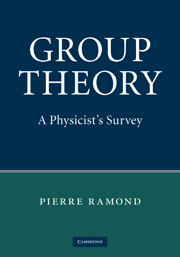Book contents
- Frontmatter
- Contents
- 1 Preface: the pursuit of symmetries
- 2 Finite groups: an introduction
- 3 Finite groups: representations
- 4 Hilbert spaces
- 5 SU(2)
- 6 SU(3)
- 7 Classification of compact simple Lie algebras
- 8 Lie algebras: representation theory
- 9 Finite groups: the road to simplicity
- 10 Beyond Lie algebras
- 11 The groups of the Standard Model
- 12 Exceptional structures
- Appendix 1 Properties of some finite groups
- Appendix 2 Properties of selected Lie algebras
- References
- Index
9 - Finite groups: the road to simplicity
Published online by Cambridge University Press: 05 March 2013
- Frontmatter
- Contents
- 1 Preface: the pursuit of symmetries
- 2 Finite groups: an introduction
- 3 Finite groups: representations
- 4 Hilbert spaces
- 5 SU(2)
- 6 SU(3)
- 7 Classification of compact simple Lie algebras
- 8 Lie algebras: representation theory
- 9 Finite groups: the road to simplicity
- 10 Beyond Lie algebras
- 11 The groups of the Standard Model
- 12 Exceptional structures
- Appendix 1 Properties of some finite groups
- Appendix 2 Properties of selected Lie algebras
- References
- Index
Summary
Earlier, we saw that finite groups can be taken apart through the composition series, in terms of simple finite groups, that is groups without normal subgroups. Remarkably the infinitude of simple groups is amenable to a complete classification. Indeed, most simple groups can be understood as finite elements of Lie groups, with parameters belonging to finite Galois fields. Their construction relies on the Chevalley basis of the Lie algebra, as well as on the topology of its Dynkin diagram. The remaining simple groups do not follow this pattern; they are the magnificent 26 sporadic groups. A singular achievement of modern mathematics was to show this classification to be complete.
So far, this beautiful subject has found but a few applications in physics. We feel nevertheless that physicists should acquaint themselves with its beauty. In this mostly descriptive chapter we introduce the necessary notions from number theory, and outline the construction of the Chevalley groups as well as that of some sporadic groups. We begin by presenting the two smallest non-Abelian simple finite groups.
A5 is simple
The 60 even permutations of the alternating group A5 are 3-ply or triply transitive. We can use this fact to prove something startling about alternating groups.
By definition, all even permutations are generated by the product of two transpositions, which can be reduced to three-cycles or the product of three-cycles.
- Type
- Chapter
- Information
- Group TheoryA Physicist's Survey, pp. 190 - 207Publisher: Cambridge University PressPrint publication year: 2010

